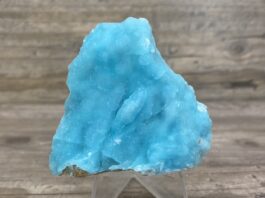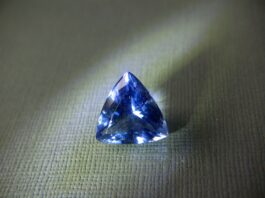Leopard Skin Jasper is a semi-precious gemstone that belongs to the chalcedony family, which also includes gemstones like agate and onyx. What sets Leopard Skin Jasper apart is its striking appearance, characterized by a combination of earthy and neutral colors, reminiscent of the patterns seen on the coat of a leopard or other big cats. Its base color is often beige, gray, or cream, and it features irregular, orb-like spots or patches in various shades of brown, black, and sometimes reddish or mustard yellow.
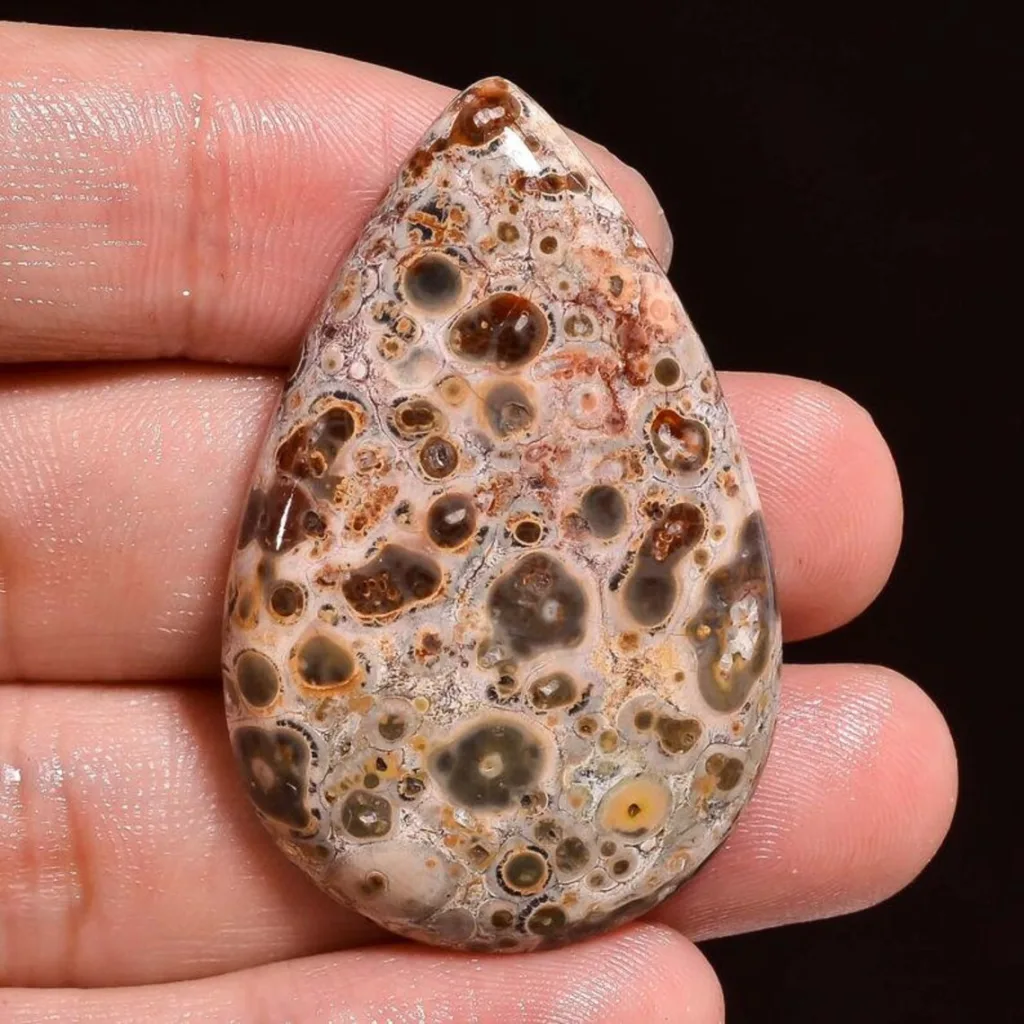
This gemstone is usually cut and polished into cabochons, beads, and other jewelry components to highlight its unique patterns. It is commonly used in the creation of jewelry, as well as in decorative objects and carvings.
Geological Formation: Leopard Skin Jasper is primarily formed through sedimentary processes. It is a type of chert, which is a microcrystalline variety of quartz. The characteristic spotted patterns are created through the presence of various minerals and impurities that infiltrate the silica-rich sediment over millions of years.
The spots and colors in Leopard Skin Jasper are often the result of iron and manganese oxide inclusions, along with other minerals like hematite, goethite, and chlorite. These impurities create the captivating, leopard-like appearance of the stone as they infiltrate and stain the silica-rich material.
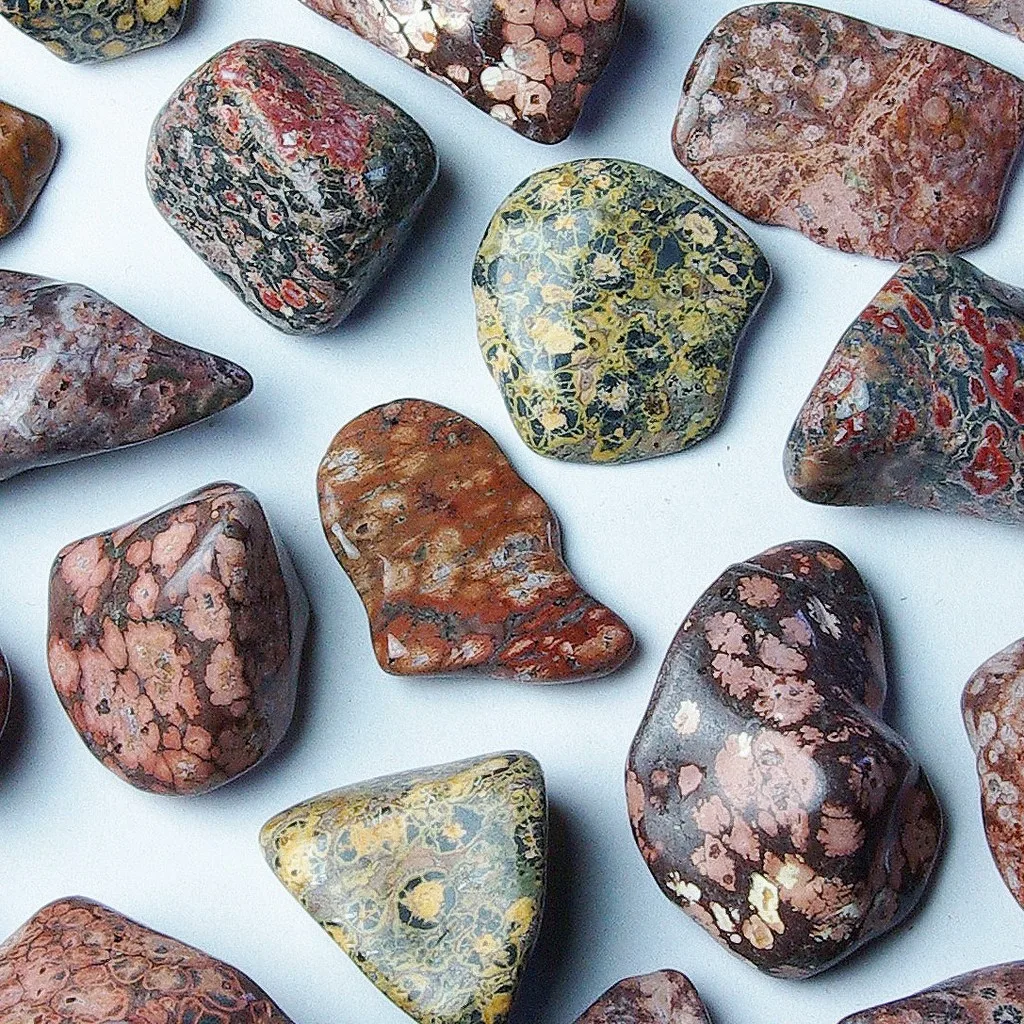
Historical Significance: Leopard Skin Jasper, like many other gemstones, has a history rooted in both ancient folklore and modern metaphysical beliefs. Historically, various cultures have ascribed mystical and healing properties to this stone, often associating it with protection, strength, and courage.
In modern times, Leopard Skin Jasper is often used in crystal healing and alternative medicine practices. It is believed to have grounding and nurturing qualities, making it a popular choice for those seeking balance and harmony in their lives. Some people use it to enhance their connection to the Earth’s energy, while others believe it can aid in self-discovery and personal growth.
While Leopard Skin Jasper may not have the same level of historical significance as some other gemstones, its unique appearance and metaphysical attributes have contributed to its popularity in the world of crystal healing and jewelry design, where it continues to be appreciated for its aesthetic and energetic qualities.
Characteristics and Appearance
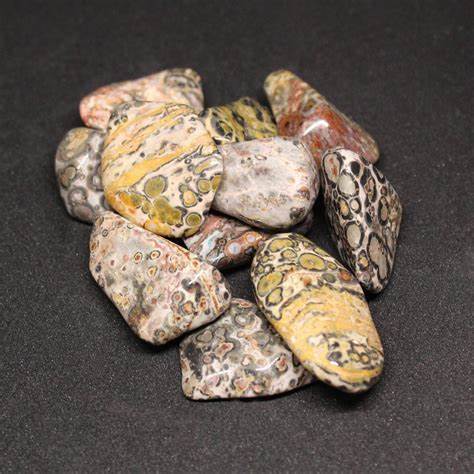
Leopard Skin Jasper is known for its distinct characteristics and unique appearance, which make it easily recognizable and highly sought after. Here are some of the key characteristics and details of this gemstone’s appearance:
- Color Palette: Leopard Skin Jasper typically has a base color that ranges from beige, gray, cream, to sometimes even pale pink or green. The most striking feature is its irregular, orb-like spots or patches that come in various shades of brown, black, and occasionally reddish or mustard yellow. These spots are often reminiscent of the markings on a leopard’s skin, hence the name.
- Patterns: The spots and patches on Leopard Skin Jasper vary in size, shape, and distribution, making each gemstone unique. Some may have densely packed spots, while others have larger, more scattered markings. The patterns can be irregular, and they often have a natural, organic appearance.
- Translucency: Leopard Skin Jasper is typically opaque, which means it doesn’t allow light to pass through it. This opacity adds to its earthy and rustic appeal.
- Texture: When touched or held, Leopard Skin Jasper has a smooth and often polished texture. It is commonly used in jewelry after being cut and shaped into cabochons, beads, and other ornamental forms.
- Luster: The luster of Leopard Skin Jasper is usually dull to waxy, and it doesn’t exhibit the high sheen or sparkle seen in some other gemstones. Its charm lies more in its intriguing patterns than its reflective qualities.
- Size: Leopard Skin Jasper can be found in various sizes, from small beads used in jewelry-making to larger specimens used for decorative purposes.
- Varieties: There are some variations of Leopard Skin Jasper with specific names, such as Dalmatian Jasper, which has smaller, black spots reminiscent of a Dalmatian dog’s coat. While similar in appearance, they may have slightly different mineral compositions.
- Fracture and Hardness: Leopard Skin Jasper has a relatively low hardness on the Mohs scale, typically ranging from 6.5 to 7. This means it can be susceptible to scratching and chipping, so care should be taken to protect it from abrasive materials.
Leopard Skin Jasper’s distinctive appearance and earthy color palette have made it a popular choice for jewelry, carvings, and other decorative items. Its unique patterns and metaphysical properties have also contributed to its appeal in the world of crystal healing and holistic practices, where it is believed to possess various energetic and healing qualities.
Occurrence and Sources
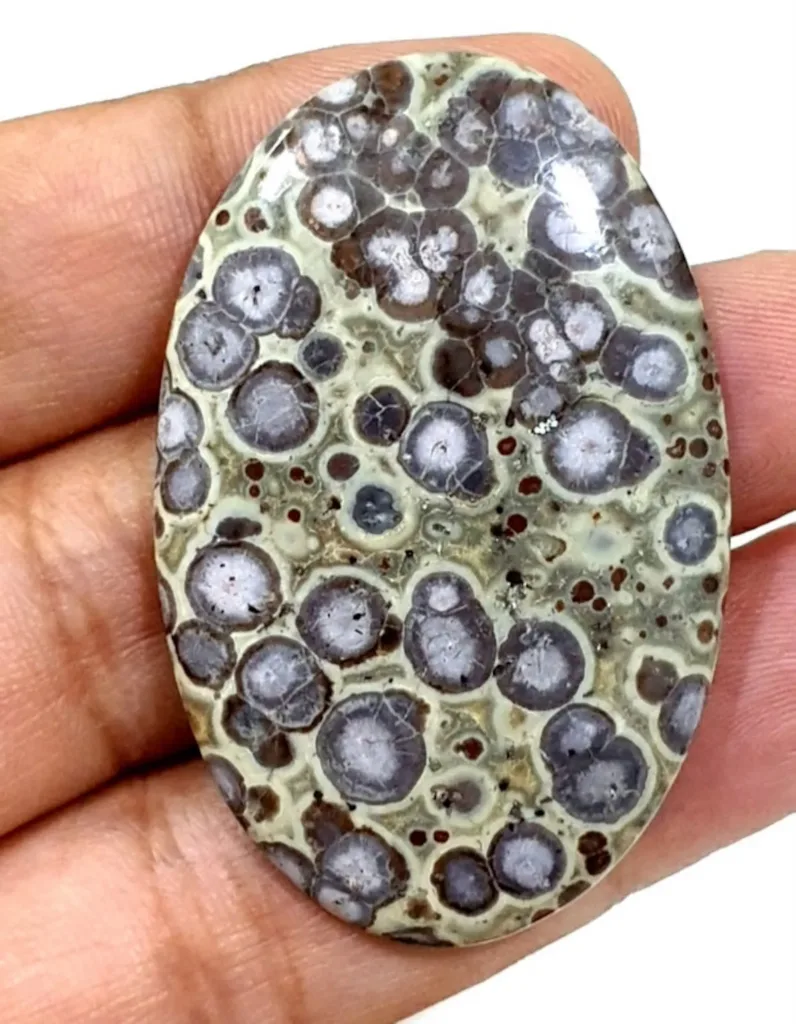
Leopard Skin Jasper is found in several locations around the world, and it occurs in areas with specific geological conditions that are conducive to its formation. Here are some of the notable sources and occurrences of Leopard Skin Jasper:
- Mexico: Mexico is one of the most well-known and prolific sources of Leopard Skin Jasper. The state of Chihuahua, in northern Mexico, is particularly renowned for its deposits of this gemstone. Mexican Leopard Skin Jasper often features the distinctive brown and black spots on a cream or beige background.
- Madagascar: Madagascar is another significant source of Leopard Skin Jasper. This island nation off the southeastern coast of Africa yields a wide variety of jasper specimens, including Leopard Skin Jasper. The stones from Madagascar often exhibit a range of colors, patterns, and quality, making them highly sought after in the gem and mineral market.
- Australia: Australia, specifically Western Australia, is known for its deposits of Leopard Skin Jasper. The stones from this region often have vibrant colors, including reddish and mustard-yellow hues, along with the characteristic brown and black spots.
- Brazil: Some Leopard Skin Jasper can also be found in Brazil. Brazilian Leopard Skin Jasper typically features the earthy tones and spots that are characteristic of this gemstone.
- Other Locations: While the aforementioned countries are the primary sources of Leopard Skin Jasper, smaller deposits can also be found in various other locations, including the United States (such as Oregon), India, Russia, and other parts of Africa.
It’s important to note that the quality and appearance of Leopard Skin Jasper can vary significantly depending on its source. Different regions may produce stones with distinct color combinations, patterns, and overall aesthetics. Collectors and enthusiasts often appreciate the diversity offered by stones from different locations.
When sourcing Leopard Skin Jasper, it’s essential to consider factors such as the stone’s origin, quality, and unique characteristics, as these aspects can influence its value and desirability in the gem and mineral market.
Uses and Applications
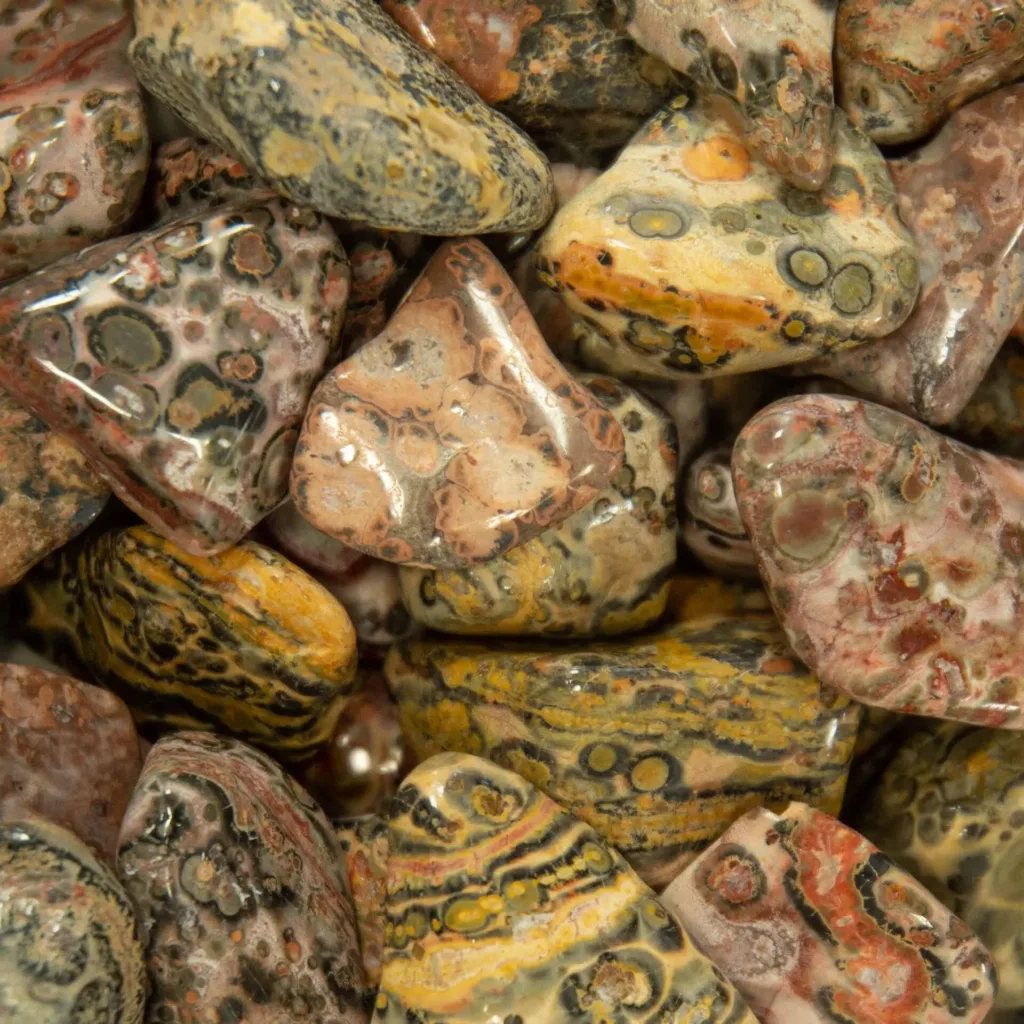
Leopard Skin Jasper, with its unique appearance and metaphysical properties, has a variety of uses and applications. Here are some of the most common ways in which this gemstone is utilized:
- Jewelry: Leopard Skin Jasper is a popular choice for jewelry making. It is often cut into cabochons, beads, pendants, and other jewelry components. The distinctive spotted patterns and earthy colors make it an attractive gemstone for creating necklaces, bracelets, earrings, and rings. Jewelry designers and wearers appreciate its natural and rustic charm.
- Decorative Objects: Leopard Skin Jasper is used in the creation of decorative items such as paperweights, bookends, and figurines. The unique patterns and colors of the stone make it an appealing choice for adding a touch of nature-inspired beauty to interior decor.
- Metaphysical and Spiritual Practices: Many people believe that Leopard Skin Jasper possesses various metaphysical and healing properties. It is often used in crystal healing and energy work. Some of its perceived properties include grounding, protection, and nurturing qualities. It is believed to help individuals connect with the Earth’s energy and find balance in their lives. Leopard Skin Jasper can be used in meditation, energy grids, or carried as a talisman for personal growth and self-discovery.
- Lapidary and Craft Projects: Artists and craftsmen use Leopard Skin Jasper in various lapidary and craft projects. It can be carved into intricate sculptures, used for inlay work, or incorporated into mosaic art. Its natural beauty and durability make it suitable for a wide range of artistic endeavors.
- Gifts and Collectibles: Leopard Skin Jasper items make thoughtful and unique gifts due to their distinctive appearance. They are often given as presents for birthdays, anniversaries, or other special occasions. Collectors may also seek out high-quality specimens or rare variations of Leopard Skin Jasper to add to their mineral and gemstone collections.
- Ornamental and Souvenir Items: In regions where Leopard Skin Jasper is sourced, it may be fashioned into souvenir items such as keychains, magnets, and small sculptures. These items serve as reminders of the gemstone’s local significance and natural beauty.
- Metaphysical Jewelry: In addition to traditional jewelry, Leopard Skin Jasper is used in metaphysical jewelry designs, often with specific intentions in mind. For example, bracelets or necklaces made with Leopard Skin Jasper beads may be created to promote protection, courage, or personal transformation.
It’s important to note that the uses and applications of Leopard Skin Jasper extend beyond its physical attributes to include its perceived energetic and healing properties. As with any gemstone used for metaphysical purposes, individuals may have their own beliefs and intentions when incorporating Leopard Skin Jasper into their practices and rituals.


